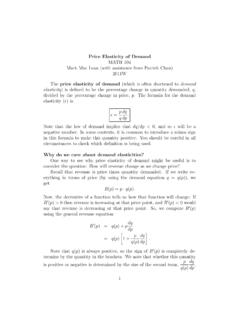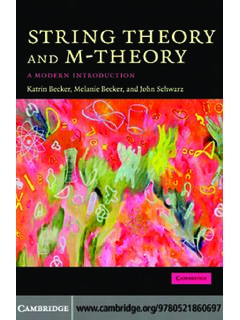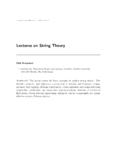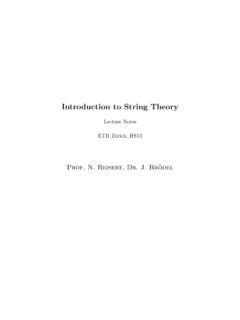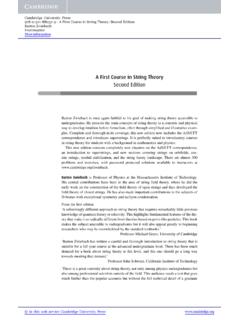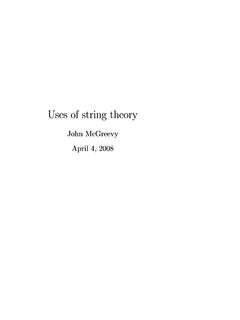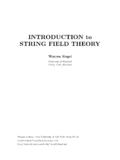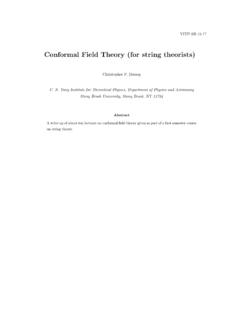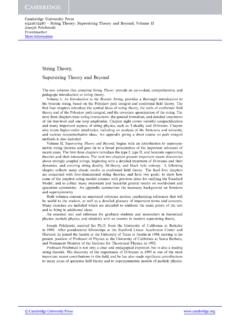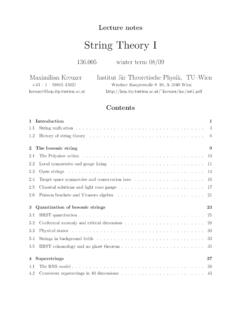Transcription of By John C. Baez and John Huerta - University of California ...
1 The Strangest Numbers in string TheoryA forgotten number system invented in the mid-19th century may provide the simplest explanation for why our universe could have 10 dimensionsBy John C. Baez and John HuertaAs children we all learn about numbers. We start with counting, followed by addition and subtraction, multiplication and division. But mathematicians know that the number system we study in school is but one of many possibilities. And indeed, other kinds of numbers are important for understanding geometry and physics. Among the strangest alternatives is the octonions. Largely neglected since their discovery in 1843, in the last few decades they have assumed a curious importance in string theory .
2 And indeed, if string theory is a correct representation of the universe, they may explain why the universe has the number of dimensions it does. The Imaginary Made RealThe octonions wouldn t be the first piece of pure mathematics that was later used to enhance our understanding of the cosmos. They wouldn t even form the first alternative number system that was later shown to have practical uses. To understand why, we first have to look at the simplest case of numbers the number system we learn about in school which mathematicians call the real numbers. The set of all real numbers forms a line, so we say that the collection of real numbers is one-dimensional.
3 We could also turn this idea on its head: the line is one-dimensional because specifying a point on it requires one real the 1500s, the real numbers were the only game in town. Then during the Renaissance, ambitious mathematicians attempted to solve ever more complex forms of equations, even holding competitions to see who could solve the most difficult problems. The square root of -1 was introduced as a kind of secret weapon by the Italian mathematician, physician, gambler and astrologer Gerolamo Cardano. Where others might cavil, he boldly let himself use this mysterious number as part of longer calculations where the answers were ordinary real numbers.
4 He wasn t sure why this trick worked; all he knew is that it gave him the right answers. He published his ideas in 1545, thus beginning a controversy that lasted for centuries: does the square root of -1 really exist, or is it only a trick? Nearly 100 years later, no less a thinker than Rene Descartes rendered his verdict when he gave it the derogatory name imaginary, or , mathematicians followed in Cardano s footsteps and began working with complex numbers numbers of the form a+bi, where a and b are ordinary real numbers. Around 1805, Jean-Robert Argand popularized the idea that complex numbers describe points on the plane. How does a+bi describe a point on the plane?
5 Simple: the number a tells us how far left or right the point is, while b tells us how far up or down it is. In this way, we can think of any complex number as a point in the plane, but Argand went a step further: he showed how to think of the operations one can do with complex numbers addition, subtraction, multiplication and division as geometric manipulations on the a warm-up for understanding how these operations can be thought of as geometric manipulations, first think about the real numbers. Adding or subtracting any real number slides the real line to the left or right. Multiplying or dividing by any positive number stretches or squashes the line.
6 For example, multiplying by 2 stretches the line by a factor of 2, while dividing by 2 squashes it down, moving all the points twice as close as they were. Multiplying by -1 flips the line same story works for complex numbers, with just a few extra twists. Adding any complex number a+bi to a point in the plane slides that point left (or right) by an amount a, and up (or down) by an amount b. Multiplying by a complex number stretches or squashes but also rotates the complex plane. In particular, multiplying by i rotates the plane a quarter turn. Thus, if we multiply 1 by i by i, we rotate the plane a full half turn from the starting point to arrive at -1.
7 Division is the opposite of multiplication, so to divide we just shrink instead of stretching, or vice versa, and then rotate in the opposite direction. Almost everything we can do with real numbers can also be done with complex numbers. In fact, most things work better, as Cardano knew, since we can solve more equations with complex numbers than with real numbers. But if a two-dimensional number system gives the user added calculating power, what about even higher dimensional systems? Unfortunately, a simple extension turns out to be impossible. An Irish mathematician would uncover the secret to higher-dimensional number systems decades later. And only now, two centuries on, are we beginning to understand how powerful they can s Alchemy In 1835, at the age of 30, the Irish mathematician and physicist William Rowan Hamilton discovered how to treat complex numbers as pairs of real numbers.
8 At the time mathematicians commonly wrote complex numbers in the form a+bi that Argand popularized, but Hamilton noted that we are also free, if we like, to think of the number a+bi as just a peculiar way of writing a list of two real numbers for instance (a, b). This notation makes it very easy to add and subtract complex numbers just add or subtract each number in the second (complex) list to the corresponding number in the first (real) list. Hamilton also came up with slightly more involved rules for how to multiply and divide complex numbers so that they maintained the nice geometrical meaning discovered by Argand. After Hamilton invented this algebraic system for complex numbers that had a geometric meaning, he tried for many years to invent a bigger algebra of triplets that would play a similar role in three-dimensional geometry, an effort that seemed to give him no end of frustrations.
9 He once wrote to his son, Every morning .. on my coming down to breakfast, your (then) little brother William Edwin, and yourself, used to ask me: Well, Papa, can you multiply triplets? Whereto I was always obliged to reply, with a sad shake of the head: No, I can only add and subtract them. Though he could not have known it at the time, the task he had given himself was mathematically impossible. Hamilton was searching for a three-dimensional number system in which he could add, subtract, multiply and divide. Division is the hard part: a number system where we can divide is called a division algebra. In 1958, three mathematicians proved an amazing fact that had been suspected for decades: any division algebra must have dimension 1 (which is just the real numbers), 2 (the complex numbers), 4 or 8.
10 To succeed, Hamilton had to change the rules of the game. Hamilton himself figured out a solution on the 16th of October, 1843. He was walking with his wife along the Royal Canal to a meeting of the Royal Irish Academy in Dublin when he had a sudden revelation. Rotations in three dimensions couldn t be described with just three numbers. He needed a fourth number, thereby generating a four-dimensional set called quaternions that take the form a+bi+cj+dk. Here, the numbers i, j and k are three unique square roots of -1. Hamilton later wrote: I then and there felt the galvanic circuit of thought close; and the sparks which fell from it were the fundamental equations between i, j, and k; exactly such as I have used them ever since.


